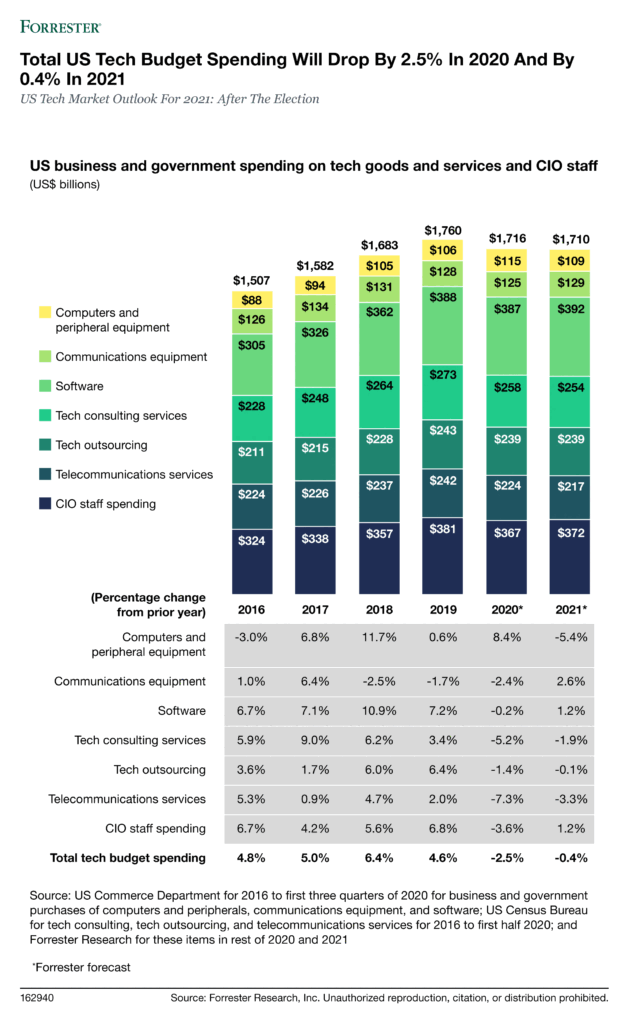Forecasting In Uncertainty: Our Latest US Tech Market Forecast Shows A 2.5% Decline In 2020 And -0.4% In 2021
The US election is now over, with Joseph Biden as President-elect, a Democratic House of Representatives, and a Republican-controlled Senate, pending the results of two Georgia Senate special elections in January 2021. The COVID-19 pandemic has roared back after a summer hiatus, but effective vaccines are now on the horizon. The US economy bounced back in Q3 2020 but is showing many signs of relapse so far in Q4 2020. Similarly, US tech investments, which weakened in Q2, turned out to be stronger than we expected in Q3. With all these developments, we at Forrester now have greater clarity on the outlook for US business and government spending on tech goods, software, services, and staff than we did in August 2020. The bottom line: just a small 2.5% drop in overall US tech spending in 2020 but continued weakness in the first half of 2021 that will lead to essentially no growth of -0.4% in 2021. Those are the headline numbers in Forrester’s report, “US Tech Market Outlook For 2021: After The Election — How Politics, The Pandemic, And The Economy Will Shape Industry Tech Budgets.”
Here are the key takeaways for the US tech market outlook for 2021:
- Better-than-expected 2020 creates a higher base for measuring 2021 US tech spending growth. In past recessions, spending on computer equipment dropped sharply — not this time. Boosted by support for work-from-home arrangements and remote teaching, computer equipment buying rose. Communications equipment spending, while down, was not cut nearly as much as in past downturns. Software spending was flat, not down, with cloud subscription growth offsetting cutbacks in license software. A similar story played out in tech outsourcing, with growth in cloud infrastructure and platform services growing while traditional outsourcing like hosting and app maintenance dropped. Tech staff spending fell slightly. Spending on tech consulting services and telecommunications services were cut more significantly, in line with our expectations. The main reason for these results was the skewed nature of the pandemic recession. Discretionary consumer-facing industries like airlines, travel, restaurants, entertainment, and leisure got hammered yet represented just 10% of the tech market. Industries like financial services, insurance, digital media and information, telecommunications, professional and business services, and government make up 75% of the US tech market but had only modest, if any, negative impacts in their tech budgets, thanks to the massive federal economic stabilization program — at least through the first three quarters of 2020, when their full effects were felt.
- A resurgent pandemic and delayed federal stimulus bill will hurt economic growth in Q4 2020 and Q1 2021 and tech budgets in the first half of 2021. While 2020 will better for the US tech market than we feared, 2021 will start off badly. Q4 2020 real GDP will almost certainly be down from Q3 2020 levels. At best, a new federal stimulus bill will not be adopted until the middle of December. At around $1 trillion, the currently debated proposal of a coalition of moderate Democratic and Republican senators would be enough to stave off a steep downturn but not enough to kick off a really strong recovery. Small and midsize business (SMB) failures will accelerate. Sectors like state and local government, financial services, and professional services that serve (and include) SMBs will come under more financial pressure, leading to cuts in overall tech spending in the first half of 2021. Still, by mid-2021, the rollout of effective coronavirus vaccines will allow businesses to start to return to normal, leading to a cautious increase in tech spending in the second half of 2021.
- Software and communications equipment spending will lead to an upturn in 2021, with computer equipment and tech consulting services lagging. Communications equipment will see the strongest demand, partly driven by business purchases to support sustained remote workforces and partly by telco investment to support expanded broadband and 5G services. Software purchases will have the second-best growth in 2021, at 1.2%, led by spending on collaboration, e-commerce, purchasing, customer service, and sales and marketing software-as-a-service products. Tech staff spending will also inch higher, by 1.2%. But computer equipment will turn negative after the splurges of 2020, telecom services spending will be weak, and tech outsourcing services will be flat (see figure below).

- Healthcare, pharma, and high tech will experience 3% to 5% increases in 2021 tech spending. These industries will benefit directly or indirectly from the rollout of coronavirus vaccines. Other industries that will see small tech budget increases in 2021 include insurance, utilities, consumer product manufacturers, and financial services. Tech spending by governments, media and information, industrial products, chemicals, transportation and logistics, telecommunication carriers, and professional and business services will be flat or down slightly. But a few industries like leisure and entertainment, social services and nonprofits, oil and gas, primary production, and wholesale trade will cut budgets more aggressively, by 3.5% to 10%.
